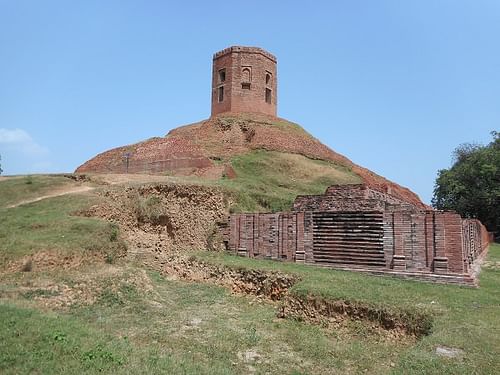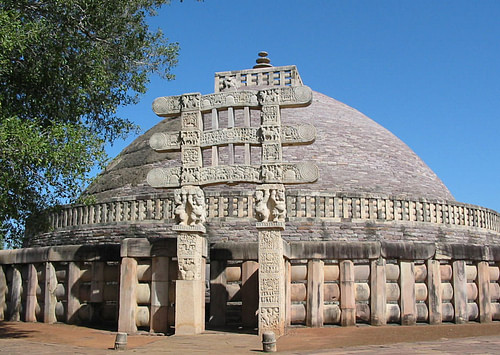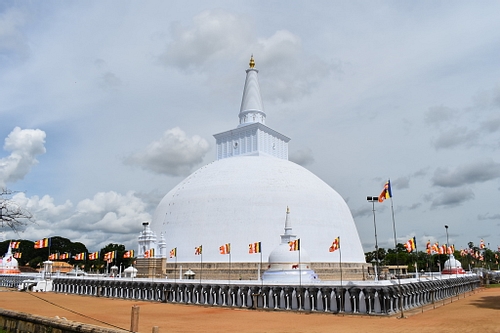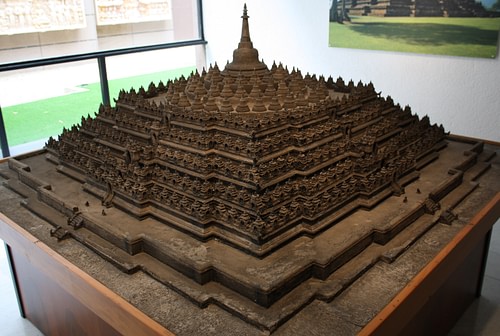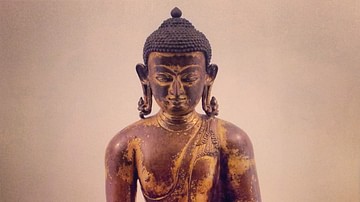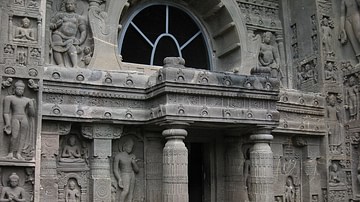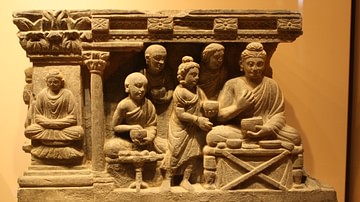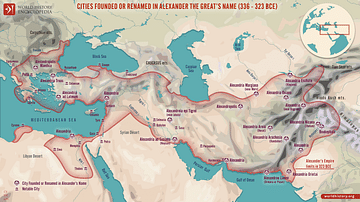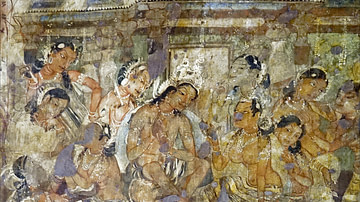
A stupa (literally “heap” or “pile”) is a reliquary, a shrine containing the remains of a holy or sainted person and/or artifacts (relics) associated with them, originating in India prior to the 5th century BCE as tombs of holy men and evolving afterwards into sacred sites dedicated to the Buddha (l. c. 563 - c. 483 BCE).
Later, stupas were also raised to honor Buddhist arhats (saints), bodhisattvas (enlightened ones), other saintly figures, or local deities. A stupa is a hemispherical structure, with a spire at the top, sometimes situated on a base that varies in shape and size (depending on the designated purpose of that particular stupa) surrounded by a walkway for visitors. Some stupas, such as the Great Stupa at Sanchi, India, or the Boudhanath Stupa at Kathmandu, Nepal, are large, ornate structures while others are more modest.
The construction of stupas, on a large scale and associated with Buddhism, began throughout India during the reign of Ashoka the Great (268-232 BCE) of the Mauryan Empire (322-185 BCE) after his conversion to Buddhism. Prior to Ashoka's reign, there were eight stupas (or ten, according to some scholars) dedicated to the Buddha (and containing his cremated remains) at different sites, which correlated to important events in his life. In an effort to spread Buddhism and encourage the enlightenment of his subjects, Ashoka had the remains disinterred and ordered the construction of many more (84,000, according to legend), each one receiving a certain allotment of the remains which empowered the structure with mystical energy.
Buddhist stupas are only one type, as there are also Hindu and Jain stupas, but Buddhist stupas remain the most popular, and their construction, worldwide, has been the most prolific. Stupas exist in countries around the world, from India to Sri Lanka, Nepal, China, European nations, Australia, the United States, and more. Whichever culture raises one of these structures, its purpose is always the same: to provide a sacred space for people to center themselves on higher thoughts and revitalize themselves spiritually.
The devotional act of building a stupa is thought to bring one good luck, health, good karma, and assure one of either an escape from the cycle of rebirth and death (samsara) which is a goal of Hinduism, Buddhism, and Jainism or, at least, a good rebirth in another life on earth in which one will attain this goal. Destruction of a stupa, conversely, brings bad luck, bad karma, and condemns one to repeated life cycles in order to atone for the sin. Stupas are, therefore, highly regarded around the world and no expense is spared in their upkeep. They are regarded as vitally important sacred sites, marking a liminal space outside of time or circumstance, wherever they are constructed, and draw visitors – of all faiths or none – on a daily basis.
Early Stupas & the Buddha
The earliest stupas were tumuli erected over the remains of mystics, ascetics, teachers, or others who had displayed profound spiritual insight. These early structures were heaps of earth and stone which either covered the cremated remains of the individual or their corpse, which was buried in a seated, meditative, position. The mound was constructed to cover the body with a wide base tapering up toward the head. This shape was used even in cases where the person had been cremated in order to symbolize the meditative posture assumed by enlightened sages.
The Buddha left instructions for his followers that his remains were to be honored in this same way, as described by scholars Robert E. Buswell, jr. and Donald S. Lopez, jr:
In the [text known as] the Mahaparinibbanasutta, the Buddha says that after he has passed away, his relics should be enshrined in a stupa at a crossroads, and that the stupa should be honored with garlands, incense, and sandalwood paste. Because of a dispute among his lay followers after his death, his relics were said to be divided into ten portions and distributed to ten groups or individuals, each of whom constructed a stupa to enshrine their share of the relics in their home region. (859)
These stupas followed the earlier shape but were more elaborate and more carefully constructed to represent the seated Buddha in the lotus position. The sites of these stupas were chosen to correlate to the most important events in the Buddha's life, including Lumbini (his birthplace), Bodh Gaya (where he attained enlightenment), the Deer Park at Sarnath (where he preached his first sermon), Kushingara (where he died). Buddhist adherents would make pilgrimages to the individual sites or, depending on their ability or level of devotion, to all of them along a sacred route whereby they would symbolically relive the Buddha's earthly existence.
Buddhism & Ashoka the Great
Buddhism was not a major religion in India even a hundred years after his death. It was a minor philosophical school which had developed, along with others, from the religious tradition of Hinduism. Hinduism is known to adherents as Sanatan Dharma (“Eternal Order” or “Eternal Path”) and the “order” alluded to (known as rita) was divine, having been set down by the supreme Lord of the Universe (who was also the Universe itself), Brahman. The order was comprehensible through the texts known as the Vedas (“Knowledge”) which were considered sacred emanations of the universe which had been “heard” by ancient sages and set down in writing. The Hindu priests of Buddha's time (5th century BCE) understood these texts and interpreted them for the people, but the people themselves did not have access to them. Various sages of the time responded by challenging the orthodox view and practice of the religion which kept all the spiritual power and control in the hands of the clergy.
This situation gave rise to a number of different schools of thought which either supported the orthodox Hindu understanding, modified it, or rejected it. The schools that supported the Hindu vision were known as astika (“there exists”) because they accepted the existence of eternal order as set down in the Vedas and their interpretation by the priests. Schools that rejected Hindu orthodoxy were known as nastika (“there does not exist”) and included Buddhism, Charvaka, and Jainism. Buddhism gained more ground earlier than Jainism, and both more than Charvaka, but it still remained a minor philosophical school until the reign of Ashoka the Great.
Ashoka was the third king of the Mauryan Empire who was described by later historians as completely ruthless and without mercy. Around 260 BCE, Ashoka decided to invade the smaller kingdom of Kalinga, which was surrounded by the Mauryan Empire and had been a long-standing partner in trade. No reason is known for the invasion since it seems both parties were benefitting equally from their relationship. For whatever reason, though, Ashoka launched a massive campaign, which destroyed Kalinga and resulted in the slaughter of 100,000 inhabitants, the deportation of 150,000 more, and the deaths of thousands of others from wounds, disease, and famine.
Ashoka took no delight in this victory, however, and was actually shocked by the carnage and senseless destruction. He renounced violence after the Kalinga campaign and, in time, devoted himself to the path of peace through Buddhism. He decreed edicts be carved throughout his empire relaying his concept of personal responsibility and Buddhist precepts and then had the Buddha's relics removed from the original stupas and enshrined in thousands of others erected all through the empire while, at the same time, sending Buddhist missionaries to other nations such as China, Greece, Sri Lanka, and Thailand. These missionaries brought the concept of the stupa to the various regions they ministered to and, once Buddhism found a place in many of these cultures, stupas were raised in Sri Lanka (known as dagobas) and China (known as pagodas) and eventually spread from these regions elsewhere.
Meaning & Function
The fundamental basis of Buddhism is that life is suffering: one suffers for want of what one does not have but, once one has that thing, suffers for fear of losing it and, once it is gone, suffers the loss. As long as one lives, one will suffer in this way but, the Buddha realized, there was a way to stop suffering, and this was to change the way one interpreted the world and one's self. Through an understanding of the Four Noble Truths, and practicing the precepts of the Eight-Fold Path, one could elevate one's understanding of existence, control one's thoughts and actions, and live at peace with one's self and others. All that one desires, fears losing, and mourns for are ephemeral – they were not made to last – and so are without final meaning; one should, therefore, appreciate these aspects of life for what they are but not cling to them since it is their nature to appear for only a short time and then vanish. The Buddhist stupa is a physical manifestation of this understanding which invites adherents to both center and elevate themselves through various rituals or simply by gathering and focusing their energies at the site.
The physical appearance of the stupa is intended to elevate the mind. The top spire (yasti) symbolizes the axis mundi (axis of the world), the line through the center of the earth which the universe revolves around. It is also thought to represent the World Tree whose roots are deep within the earth and branches in heaven, a symbol common in many cultures around the world. The yasti is surrounded by a square gate known as the harmika, and over the yasti and harmika are parasols which symbolize protection, majesty, and the Buddha himself. The large hemisphere descends from the yasti to a platform or base, sometimes square, which is often surrounded by a wall with four gates (toranas) corresponding to the four cardinal directions. These directions, in turn, relate to four events in Buddha's life:
- East – Birth of Buddha
- South – Enlightenment of Buddha
- West – First Sermon of Buddha
- North – Nirvana/Release from Samsara of Buddha

The whole effect is to create the impression of Mount Meru, the spiritual center of the universe in Buddhist, Hindu, and Jain cosmology. The stupa, then, is sacred space – no matter where it is located or what structures surround it – where one may commune with the bright and tranquil energies which infuse the structure. Scholars Buswell and Lopez comment:
Each of these architectural elements would evolve in form and eventually become imbued with rich symbolic meaning as the stupa evolved in India and across Asia. The relics enshrined in the stupa are considered by Buddhists to be living remnants of the Buddha (or the relevant saint) and pilgrimage to, and worship of, stupas has long been an important type of Buddhist practice. For all Buddhist schools, the stupa became a reference point denoting the Buddha's presence in the landscape. Although early texts and archaeological records link stupa worship with the Buddha's life, and especially the key sites in his career, stupas are also found at places that were sacred for other reasons, often through an association with a local deity. (860)
Visitors to the site will either prostrate themselves before the stupa multiple times, circumambulate clockwise around it on a walking path, do both, or do nothing at all. The circumambulation is the ritual most closely associated with images of stupas in the modern day. One enters the site through one of the four gates and then proceeds around the stupa, clockwise, reciting mantras, prayers, and chants, frequently touching the wall of the structure or placing written prayers into slots. There are sometimes ritual observances of this circumambulation a certain number of times in a 24-hour period at stupas. One must proceed clockwise (to the right around the stupa) to follow the natural course of the sun and its energy which produces light, life, and encourages growth and transformation; to proceed counterclockwise is to direct one's energy against the natural flow of life and, in essence, attempt to “unwind” the natural order and balanced state of existence. Proceeding counterclockwise at a stupa, therefore, is prohibited.
Famous Stupas & Their Purpose
The most famous stupa complex in India (and the one most often depicted in defining a stupa) is at Sanchi in the State of Madhya Pradesh. The complex features the Great Stupa (Mahastupa) commissioned by Ashoka the Great, temples, pillars, reliefs, and other stupas. Work on the Great Stupa is said to have been overseen by Ashoka himself who erected one of his pillars, inscribed with his edicts, on the site. The pillar of Ashoka at Sanchi can still be seen at the complex. The toranas of the Grand Stupa are intricately carved and ornamented but the Buddha himself, in physical form, is not depicted; his presence is suggested by reliefs showing his footprints, his eyes, the parasol symbolizing his protection, or by animals associated with his life and ministry. Spirits and earlier fertility deities are also depicted on the toranas, emphasizing the all-inclusive and welcoming nature of the site.
In Sri Lanka, the first region to embrace Buddhism on a large scale outside of India, there are a number of impressive stupas. The best-known is probably Ruwanwelisaya which attracts Buddhist adherents from all over the world because it contains the greatest amount of the Buddha's relics of any stupa anywhere else and so is thought to offer the greatest amount of spiritual energy and power.
Nepal is the home to two of the other famous stupas – Boudhanath Stupa and Swayambhunath Stupa – both in Kathmandu. The Boudhanath Stupa is one of the largest in Nepal and in the world. It was built directly on a trade route from Tibet through the region and has become a religious center for Tibetan refugees fleeing Chinese persecution. It is said to hold the relics of a later Buddha and is continuously cared for. The structure was damaged in an earthquake in 2015 CE and restored at a cost of over 2,000,000 US dollars. The Swayambhunath Stupa is, according to tradition, self-created (emerging from the earth naturally) and home to powerful spiritual energies who keep the earth in balance. This stupa was also damaged in the 2015 CE earthquake and restored. A miniature model is among the exhibits of the Asian Art Museum of San Francisco, USA, with all of the features of the stupa reproduced perfectly including the four Buddhas around the top and the Eyes of the Buddha above them on all four sides – a central feature of many stupas.
The largest stupa complex in the world is Borobudur in Java, Indonesia, completed in the 9th century CE. Borobudur is a major Buddhist pilgrimage site where visitors are welcome to circumambulate up nine levels of the immense structure, contemplating innumerable statues and reliefs relating to the life and vision of the Buddha, so that they are able to both physically and psychologically elevate themselves above the world of everyday life.
The above stupas date from the early centuries of the common era but many others have been built around the world in the last 100 years or even more recently. The tallest stupa in Europe is Benalmadena Stupa in Andalusia, Spain, completed in 2003 CE, and rising to a height of 108 feet (33 meters). In the United States, the largest stupa is The Great Stupa of Dharmakaya Which Liberates Upon Seeing in Red Feather Lakes, Colorado, completed in 2001 CE. Its name suggests a principal function of the stupa, no matter where it is raised, of elevating and liberating the soul from ignorance, selfishness, spiritual darkness, and the cycle of rebirth and death.
A more modest but no less impressive stupa was raised at the Amitabha Stupa and Peace Park in Sedona, Arizona in 2004 CE which attracts many visitors daily. Guests offer sacrifices for world peace and understanding as well as petitions for personal issues and prayers of gratitude. The grand vision of the Great Stupa of Universal Compassion in Victoria (Bendigo), Australia (consecrated in early 2020 CE) follows this same paradigm of raising a stupa and surrounding complex to encourage kindness, understanding, and empathy among people around the world.
Conclusion
All stupas, everywhere, no matter their age or surroundings, encourage this same concept of spiritual liberation, compassion for others, and loving respect for all living things. This vision is epitomized by the Ice Stupa Project of Ladakh, India, pioneered by the engineer Sonam Wangchuk (b. 1966 CE) which creates ice stupas in order to irrigate the land naturally. The structures are made by freezing water on a stupa-shaped frame in winter high on the mountainside and, when the ice stupa melts in spring, the water flows down to the fields below.
The project was initiated in 2013 CE and continues to the present in an effort to balance the effects of global warming in the region. The ice stupas serve the same purpose as their ancient stone counterparts in elevating the lives of those who build and benefit from them as well as nurturing the natural environment and encouraging greater care for the earth.
